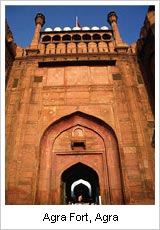| Agra
Fort (Agra) |
 Introduction: Introduction:
Agra Fort is one of the most important
and robustly built stronghold of the Mughals, embellished
with number of richly decorated buildings encompassing the
imposing Mughal style of art and architecture. Agra Fort has
a history that spans two generations of the Mughal emperors.
Started during the reign of the Mughal emperor Akbar (1556-1605),
the construction work on the Agra Fort continued till the
reign of his grand son Shah Jahan (1627-58). Though started
by Akbar in 1565, it was Shah Jahan, who constructed most
of the buildings inside the fort. Akbar was the third Mughal
emperor and undoubtedly the greatest. He was crowned the Mughal
ruler in 1556 at the tender age of 14, when his father Humayun
died suddenly. After Akbar consolidated his rule, he began
constructing the Agra Fort, which coincided with the building
of Humayun's tomb in Delhi. Akbar began the construction of
this massive fort made of red sandstone on the banks of the
Yamuna in 1565. The fort was ready by 1571, though additions
were made up until the rule of Shahjahan, who was Akbar's
grandson. During the time of Akbar, the fort mainly served
military purpose, while by the time of Shahjahan it also served
as a palace and court.
The fort's colossal double walls rise 20 m in height and measure
2.5 km in circumference. The fort is surrounded by a moat.
The lofty battlements of the Agra fort cast its protective
shadow over the far stretching mansions of nobles and princes
built along the riverfront. The magnificent towers, bastions
and ramparts and majestic gateways symbolized the confidence
and power of the third Mughal emperor. The fort contains splendid
palaces both in red sandstone and white marble built by two
generations of prolific builders, Akbar and later on by Jahangir
and Shahjahan. Of the nearly 500 Akbari buildings built in
the Bengal and Gujarati traditions, only a few have survived,
arrayed in a band on the riverfront. |
|
|
|
 |
All rights
Reserved. Best Viewed at 1024 x 768 using Netscape or Internet
Explorer version 5.0 or above.
Copyright ©2006-2007 CR License, LLC. All Right Reserved.
Terms of Use | Privacy Policy | Travel Agents |
|
|

